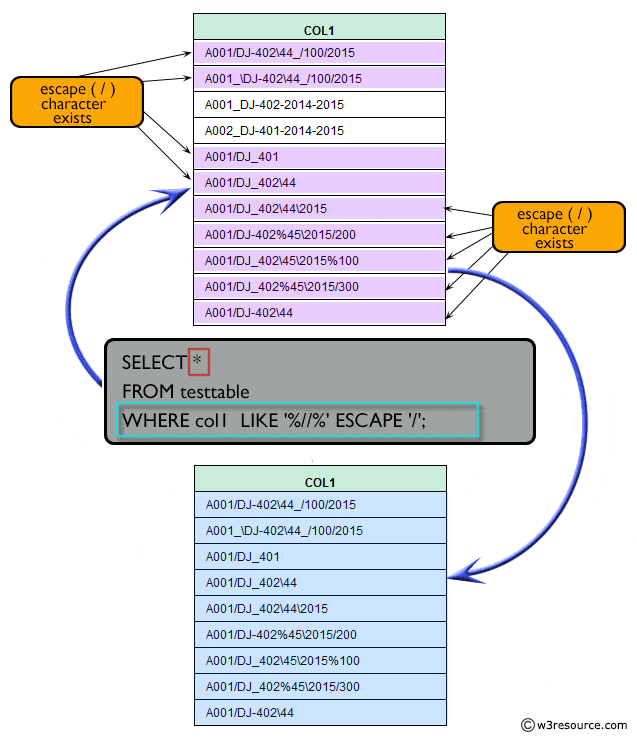SQL Exercises: Where clause with like operator and escape character
14. Rows with Forward Slash Character
From the following table, write a SQL query to find rows in which col1 contains the forward slash character ( / ). Return col1.
Sample table: testtable
col1 -------------------------- A001/DJ-402\44_/100/2015 A001_\DJ-402\44_/100/2015 A001_DJ-402-2014-2015 A002_DJ-401-2014-2015 A001/DJ_401 A001/DJ_402\44 A001/DJ_402\44\2015 A001/DJ-402%45\2015/200 A001/DJ_402\45\2015%100 A001/DJ_402%45\2015/300 A001/DJ-402\44
Sample Solution:
-- This query selects all columns from the 'testtable'.
SELECT *
-- Specifies the table from which to retrieve the data (in this case, 'testtable').
FROM testtable
-- Filters the rows to only include those where the 'col1' column:
-- - Contains the sequence of characters '%//%'.
-- The ESCAPE clause is used to escape the special character '/' in the pattern.
WHERE col1 LIKE '%//%' ESCAPE '/';
Output of the Query:
col1 A001/DJ-402\44_/100/2015 A001_\DJ-402\44_/100/2015 A001/DJ_401 A001/DJ_402\44 A001/DJ_402\44\2015 A001/DJ-402%45\2015/200 A001/DJ_402\45\2015%100 A001/DJ_402%45\2015/300 A001/DJ-402\44
Code Explanation:
The said SQL query selects all columns (*) from a table called 'testtable' where the value in the "col1" column contains the characters "//" (with any characters before and after it).
The "ESCAPE '/'" clause specifies that when a forward slash character (/) is inserted into a string, it should be treated as an escape character, meaning that it should be treated as if it were a literal character (in this case, the second forward slash in the "LIKE" clause).
Explanation :
Visual presentation :
Go to:
PREV : Rows Without Underscore Character.
NEXT : Rows Without Forward Slash Character.
Practice Online
For more Practice: Solve these Related Problems:
- Write a SQL query to find rows where col1 contains the forward slash ( / ) followed by a number. Return col1.
- Write a SQL query to retrieve rows where col1 starts with a forward slash ( / ). Return col1.
- Write a SQL query to find rows where col1 ends with a forward slash ( / ). Return col1.
- Write a SQL query to list rows where col1 contains two consecutive forward slashes ( // ). Return col1.
Contribute your code and comments through Disqus.
What is the difficulty level of this exercise?
Test your Programming skills with w3resource's quiz.


